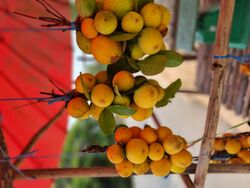Biology:Willughbeia edulis
| Willughbeia edulis | |
|---|---|

| |
| Willughbeia edulis, known as Kouy fruit, for sale in Cambodia | |
| Scientific classification | |
| Kingdom: | Plantae |
| Clade: | Tracheophytes |
| Clade: | Angiosperms |
| Clade: | Eudicots |
| Clade: | Asterids |
| Order: | Gentianales |
| Family: | Apocynaceae |
| Genus: | Willughbeia |
| Species: | W. edulis
|
| Binomial name | |
| Willughbeia edulis Roxb.
| |
| Synonyms[1] | |
| |
Willughbeia edulis[2] is a vine species bearing tropical fruit in the family Apocynaceae.
Etymology
The tropical plant genus Willughbeia all commemorate Francis Willughby, English ornithologist and ichthyologist.[3] Edulis comes from the Latin, which translates as edible.[4] In fact, it is one of the rare climbing plants of Southeast Asia of which the fruits are eatable.[5]
Description
It is a yellow sour edible fruit found in: India, Indo-China (Cambodia, Myanmar, and Isan (northeastern) with Chanthaburi Province of Thailand[6] as well as Vietnam) include Peninsular Malaysia. It may be known under a number of synonyms including "Willughbeia cochinchinensis".[7]
After its reddish lenticelled stems are excised, they exude a milky latex which produces a rubber called chittagong.[8] The roots can be used as a red dye[9] and it may be used medicinally in parts of Asia including Cambodia.
Vernacular names
Local names include: kuy (គុយ) in Cambodia; gedraphol, laleng-tenga, bel-tata in India; dton-kuy (ต้นคุย), kuiton (เถาคุย), kreua (เครือ), and katong-katiew (กะตังกะติ้ว) in Thai; bak yang-pa (บักยางป่า) in Isan dialect.[6][9] talaing-no in Myanmar; and guồi in Vietnamese.[10]
Kubal madu in Indonesia refers to a similar edible relative, W. sarawacensis.
References
- ↑ "Willughbeia edulis " (in en). Royal Botanic Gardens, Kew. http://www.plantsoftheworldonline.org/taxon/1009147-1 . Retrieved 14 December 2022.
- ↑ Roxburgh W (1820) Plants of the Coast of Coromandel 3: 77.
- ↑ Birkhead, Tim (2018). The wonderful Mr Willughby : the first true ornithologist. London. pp. 259. ISBN 978-1-4088-7848-4. OCLC 1001924209. https://www.worldcat.org/oclc/1001924209.
- ↑ Wiart, Christophe (2006-06-19) (in en). Medicinal Plants of Asia and the Pacific. CRC Press. pp. 257. ISBN 978-1-4200-0680-3. https://books.google.com/books?id=SofMBQAAQBAJ&dq=Willughbeia+edulis&pg=PA257.
- ↑ Kurz, Sulpiz (1877) (in en). Forest Flora of British Burma. Office of the superintendent of government printing. pp. 162. https://books.google.com/books?id=_lZHAAAAYAAJ&dq=Willughbeia+edulis&pg=PA162.
- ↑ 6.0 6.1 "เจษฎาโอ้โฮ : บักยางป่า" (in thai). Channel 7 HD. 2020-04-10. https://news.ch7.com/detail/405940. Retrieved 2020-04-16.
- ↑ Kuy fruit
- ↑ Wiart, Christophe (2006-06-19) (in en). Medicinal Plants of Asia and the Pacific. CRC Press. pp. 257. ISBN 978-1-4200-0680-3. https://books.google.com/books?id=SofMBQAAQBAJ&dq=Willughbeia+edulis&pg=PA257.
- ↑ 9.0 9.1 "??ع??-->??ع?ôͷ???". http://www.samunpri.com/modules.php?name=Herbs&file=thor&func=thor14.
- ↑ http://www.foodplantsinternational.com/index.php?sec=plants&page=simple_info&plantid=17519&nocache=1 Food Plants International Helping the Hungry Feed Themselves
External links
Wikidata ☰ Q8022505 entry
 |

